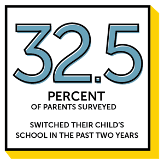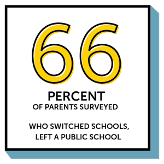 Providing a Framework for Your Communications Plans
Providing a Framework for Your Communications Plans
By Jacqlyn Burde, managing director, director of education marketing, Galapagos Marketing
Every year, Galapagos surveys a representative sample of parents across Michigan. Why? Because it provides a glimpse into what K-12 parents value most about their children’s schools. Armed with this insight, schools can better frame their marketing plans, communicate what sets them apart, and attract more families to their district.
Since the Covid pandemic, public school enrollment is down by 1.1 million students. This is partly due to decreased birth rates, but also because parents are making an active choice to not return to public schools.
For many families, Covid opened their eyes to other options when it comes to education for their K-12 students. They began looking at your competitors, either brick-and-mortar, online, or even right at home. As Thomas S. Dee simply put it in a November 2nd, 2022 article in Education Week, post-Covid, “A broad return to public school simply did not happen.”
And our Michigan-focused parent survey revealed something similar. Our December 2022 survey indicated that 32.5% of respondents (parents) switched their child’s school in the past two years, up from 20% in our 2021 parent survey. Of the 32.5% who switched, 66% left public schools.
 |
 |
As a district up against nationally declining enrollment, it’s vital to focus your communications on what is most important to parents. Finding out what their needs are and how you can deliver on those needs, will be the key to bringing families back.
So, what do parents value most?
For any brand, including yours, knowing consumer needs is everything. Athletics, STEM, mental health support, secure facilities—just to name a few—are all crucial offerings in any district. But as a school district trying to put together a focused communications plan, you must narrow the list to be efficient, effective, and relevant. People connect with brands that meet them where they are; brands that see a need in their lives and deliver.
When we asked parents to choose what they value about their child’s school, our survey revealed that 56% of parents value quality teachers; 55% value convenience; and 40% value safety and security. When asked to choose their single most important school resource, they chose quality teachers first (25%), safety and security second (14%), and third, convenience (12%).

This is great news. For years, and certainly pre-pandemic, we did not see quality teachers rise to the top. In fact, our 2021 survey had quality teachers as the 4th most valued aspect of education.
In our current state where schools are scrutinized for almost everything, there’s nothing more unbiased or apolitical than focusing on your amazing teachers. What are they doing in the classroom? How can you remind parents of their expertise and value?
This requires more than hugs and smiles.
This is showcasing the masters of their crafts that your teachers are. What really happens in your PD sessions? What types of strategies are your teachers learning, honing, perfecting, and then implementing for students? And how are students benefitting from this commitment and expertise?
Safety and security are long-standing needs for parents. When we began surveying parents over eight years ago, safety and security always ended up in the top three of parents’ priorities; many times, landing at number one. Incorporating consistent messaging around this is not easy. It’s a complex need for parents to feel like their child is safe and secure in school. Yes, it’s secure entrances, school resource officers, and active shooter drills, but it’s also school culture and, most importantly, trust.
Trust stems from transparent, authentic, and timely school-parent communications. Your district is not perfect and neither are the students you serve, but if you can commit to these three aspects of trust in your communications, your parents’ need for their child to be safe and secure will be met. We have one client committed to sending a parent communication home if there is any sort of physical altercation in school – before the kids get off the bus that same day. While this does not happen often, parents know what has happened before their kids get home and can initiate conversation rather than react. It has increased trust in this district, along with satisfaction and Net Promoter Scores.
Like safety and security, convenience is a long-standing top-three parent need and one we find surprises many of our clients. If you think about your parents as consumers in the world we live in, you would not find this need surprising. As consumers, we need things to be convenient. That is why giants like Amazon increased sales by $14 billion from 2021 to 2022. That is why our phones are filled with apps and almost every successful retailer offers curbside pickup.
But what does this have to do with schools?
That’s a great question.
It’s not an easy realization to come to, but you are up against the convenient experiences offered by other organizations like Amazon. Consumers generalize about what’s possible, so if it’s possible to order coffee to pick up on their way past Starbucks in 12 minutes, they expect schools to accommodate their immediate needs just the same.
The better question then to ask is: How can you make things more convenient for parents? Look at your school organization and the processes you have established and find ways to streamline them so that parents can do what they want more easily. Things like centralized registration, online and mobile payments for sports, clubs, and field trips should be the direction you’re shifting toward. Find an easy way for parents to leave feedback – both positive and negative – anywhere they are. With QR codes cleverly placed across your district, you can not only offer a convenient way for parents to share thoughts with you, but you can also learn more about their needs.
Where to start
As Amelia Earhart once said, “The most effective way to do it, is to do it.” There are a lot of places you can start and while none of them are wrong, pulling out three parent needs to focus on in the coming year can help you improve your enrollment efforts, streamline your communications, and ensure you’re staying relevant to parents. You have so much to offer, now it’s time to share it consistently and with authenticity.
Click here for the full 2022 Galapagos Parent Survey Report.
About Galapagos
We believe it’s not the biggest or the strongest that thrives, it is those that know how to adapt, change—and successfully tell their story. Galapagos provides insight-driven strategy and marketing services to both community financial institutions and K-12 schools throughout the country.
Our team of data analysts, strategists, professional communicators, and graphic designers have taken some of the most disciplined and effective marketing strategies and successfully applied them to education and the significant issues that school districts face.
Learn more at GalapagosEDU.com.
About the Author:
Jacqlyn Burde joined Galapagos in 2017 after owning a strategic marketing firm for nine years, focusing on schools and financial institutions. As a member of the Galapagos team, she focuses on integrated growth strategies that position schools to boost enrollment by addressing every problem area of the district, both internal and external. Passionate about the power of educators, Jacqlyn has trained teachers, boards of education, front line staff, and administrators to focus their influence to help grow enrollment, community pride, and family engagement.
A marketer for over two decades, she has been working with public schools for over 15 years. Jacqlyn received an MBA from Davenport University and a BA from Spring Arbor University. In 2008, she completed the Robert M. Perry School of Banking at Central Michigan University.
Constantly caffeinated, in her spare time she relives her glory days as a college athlete by coaching youth sports. She and her family are avid travelers enjoying the beautiful state of Michigan, anywhere with mountains to hike, as well as traveling internationally.
